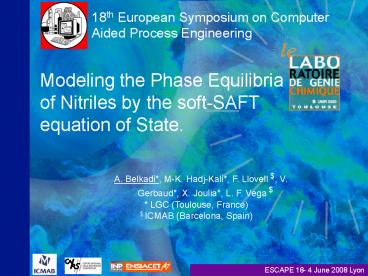Prsentation PowerPoint - PowerPoint PPT Presentation
1 / 15
Title: Prsentation PowerPoint
1
18th European Symposium on Computer Aided Process
Engineering
Modeling the Phase Equilibria of Nitriles by the
soft-SAFT equation of State.
A. Belkadi, M-K. Hadj-Kali, F. Llovell ,
V. Gerbaud, X. Joulia, L. F. Vega LGC
(Toulouse, France) ICMAB (Barcelona, Spain)
2
Introduction
Process simulation
Thermodynamic modeling
Phase equilibrium
Cubic EoS
Molecular based EoS
SRK / PR /
Tc / Pc / ?
SAFT / CPA /
s / e / Q
Pure compounds data base
Thermodynamicproperties
Thermodynamic models
3
Why using a molecular based EoS (SAFT) ?
- Direct access to fluid intrinsic properties
- Strong physical meaning of the molecular
parameters. - Accurate prediction of VLE of heavier molecules
by extrapolation of molecular parameters fitted
on small molecules. - Handling of complex fluids (ionic liquids VLLE,
electrolytes, quadrupolar solvents, hydrogen
bonding mixtures)
4
Outline
- Introduction
- Statistical Associating Fluid Theory
- Nitriles Family Previous works and present work
- Methodology
- Isomers distinction (iso- and nbutyronitrile)
- Binary VLE calculations (ACN-CO2)
- Conclusions and perspectives
5
Statistical Associating Fluid Theory (1/3)
(Chapman et al.1989)
Sum of molecular interactions
- Segments interactions (reference fluid)
- Chain formation
- Association
- Polarity
Free Helmholtz energy (A)
Aseg
Aid
Achain
Aassoc
Apol
A
6
Statistical Associating Fluid Theory (2/3)
Terms of the soft-SAFT equation
Pv
Zmultipole
Z
1
Zassoc
Zseg
Zchain
RT
7
Statistical Associating Fluid Theory (3/3)
- Parameters of the soft-SAFT equation
s
Chain molecules
e/kB
m
eHB/kB
Associative molecules
?HB
Polar molecules
µ,Q
8
Previous works the proposed model
Nitriles model with soft-SAFT EoS
- Literature models (Spuhl al. 2004) with PC-SAFT
EoS
Chain formation
Association
Polar
AAD(?liq)
Model 1
12.08
?
?
?
Model 2
3.11
?
?
?
?
?
?
0.89
Model 3
- Experimental NMR data (Jackowski et al, 1995)
association due to the strong interaction between
CN groups
s,e
Proposed model in this work
Lennard-Jones spheres
Chain formation
Association
Polar
9
Methodology (3 steps)
- Optimize molecular parameters of light nitriles
Vapor liquid equilibrium
- Linear correlation of SAFT molecular parameters
as a function of molecular weight MW within the
homologous serie - Transferability by extrapolation to heavier
nitriles valeronitrile and hexanontirile
10
Step1 ? parameter fitting on Light nitriles
CH3CN
C2H5CN
C3H7CN
DIPPR data base
11
Step 2 ? Linear correlations
molecular parameters function (Mw)
Step 3 ? Transferability
C4H9CN
C5H11CN
12
Results
Solid lines soft-SAFT predictionsSymbols DIPPR
data base
Pure compounds VLE
AAD(?liq) 0.7
AAD(Psat) 2
Light nitriles (aceto, propio and butyro)
Heavy nitriles (valeor and hexano)
Temperature dependence of the mole fraction of
monomers
Figure 2 Molar fraction of acetonitrile monomers
predicted by soft-SAFT approach
13
Isomer distinction
14
Binary mixture calculations (ACN CO2)
(without any binary parameters)
Exp Data R. Wiebe, V. L. Gaddy, J. Am. Chem.Soc.
62 (1940) 815-817.
(?) 298K (?) 308K (?) 343K () 373K
15
Conclusions
- A valid approach to model heavy molecules,
- Mimicking the strong polar behavior of nitriles
by a single association, - Possibility to distinguish isomers,
Perspectives
- Improve SAFT predictions capacity in mixtures
- by fitting the binary interaction parameters
- Improve pure nitriles modeling by taking into
account the dipolar contribution - Test cross-association schemes (water-acetonitrile
)































